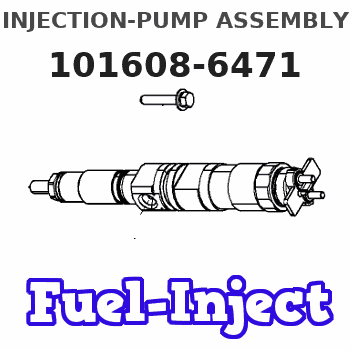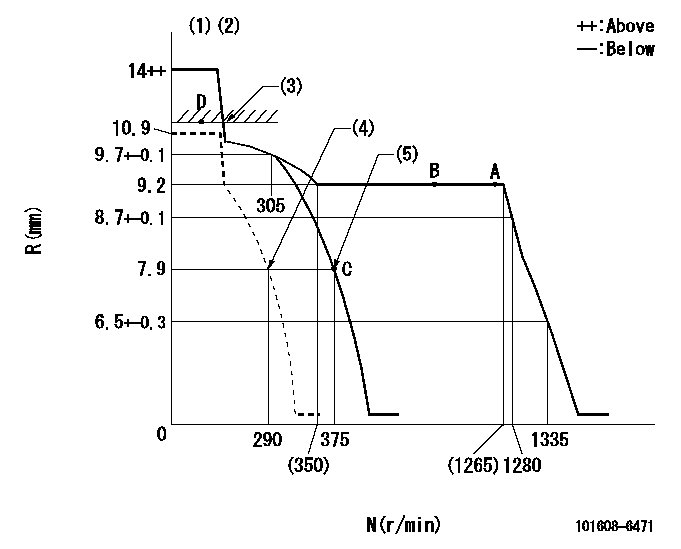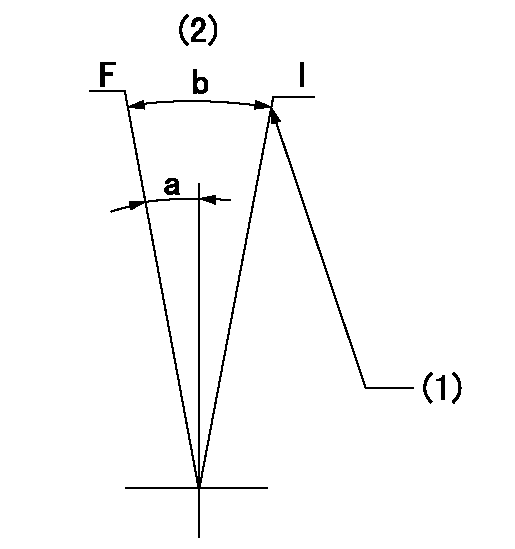Information injection-pump assembly
BOSCH
9 400 613 381
9400613381
ZEXEL
101608-6471
1016086471
MITSUBISHI
ME441278
me441278

Rating:
Service parts 101608-6471 INJECTION-PUMP ASSEMBLY:
1.
_
6.
COUPLING PLATE
7.
COUPLING PLATE
8.
_
9.
_
11.
Nozzle and Holder
ME441640
12.
Open Pre:MPa(Kqf/cm2)
21.6{220}
15.
NOZZLE SET
Include in #1:
101608-6471
as INJECTION-PUMP ASSEMBLY
Include in #2:
104740-0930
as _
Cross reference number
BOSCH
9 400 613 381
9400613381
ZEXEL
101608-6471
1016086471
MITSUBISHI
ME441278
me441278
Zexel num
Bosch num
Firm num
Name
101608-6471
9 400 613 381
ME441278 MITSUBISHI
INJECTION-PUMP ASSEMBLY
6D34TL K 14BE INJECTION PUMP ASSY PE6A PE
6D34TL K 14BE INJECTION PUMP ASSY PE6A PE
Calibration Data:
Adjustment conditions
Test oil
1404 Test oil ISO4113 or {SAEJ967d}
1404 Test oil ISO4113 or {SAEJ967d}
Test oil temperature
degC
40
40
45
Nozzle and nozzle holder
105780-8140
Bosch type code
EF8511/9A
Nozzle
105780-0000
Bosch type code
DN12SD12T
Nozzle holder
105780-2080
Bosch type code
EF8511/9
Opening pressure
MPa
17.2
Opening pressure
kgf/cm2
175
Injection pipe
Outer diameter - inner diameter - length (mm) mm 6-2-600
Outer diameter - inner diameter - length (mm) mm 6-2-600
Overflow valve
131424-5520
Overflow valve opening pressure
kPa
255
221
289
Overflow valve opening pressure
kgf/cm2
2.6
2.25
2.95
Tester oil delivery pressure
kPa
255
255
255
Tester oil delivery pressure
kgf/cm2
2.6
2.6
2.6
Direction of rotation (viewed from drive side)
Right R
Right R
Injection timing adjustment
Direction of rotation (viewed from drive side)
Right R
Right R
Injection order
1-5-3-6-
2-4
Pre-stroke
mm
3.5
3.45
3.55
Beginning of injection position
Drive side NO.1
Drive side NO.1
Difference between angles 1
Cal 1-5 deg. 60 59.5 60.5
Cal 1-5 deg. 60 59.5 60.5
Difference between angles 2
Cal 1-3 deg. 120 119.5 120.5
Cal 1-3 deg. 120 119.5 120.5
Difference between angles 3
Cal 1-6 deg. 180 179.5 180.5
Cal 1-6 deg. 180 179.5 180.5
Difference between angles 4
Cyl.1-2 deg. 240 239.5 240.5
Cyl.1-2 deg. 240 239.5 240.5
Difference between angles 5
Cal 1-4 deg. 300 299.5 300.5
Cal 1-4 deg. 300 299.5 300.5
Injection quantity adjustment
Adjusting point
A
Rack position
9.2
Pump speed
r/min
1250
1250
1250
Average injection quantity
mm3/st.
74
73
75
Max. variation between cylinders
%
0
-2.5
2.5
Basic
*
Fixing the lever
*
Injection quantity adjustment_02
Adjusting point
-
Rack position
8.1+-0.5
Pump speed
r/min
375
375
375
Average injection quantity
mm3/st.
11
9.7
12.3
Max. variation between cylinders
%
0
-14
14
Fixing the rack
*
Remarks
Adjust only variation between cylinders; adjust governor according to governor specifications.
Adjust only variation between cylinders; adjust governor according to governor specifications.
Injection quantity adjustment_03
Adjusting point
D
Rack position
9.4++
Pump speed
r/min
100
100
100
Average injection quantity
mm3/st.
65
65
70
Fixing the lever
*
Rack limit
*
Timer adjustment
Pump speed
r/min
0
Advance angle
deg.
3
2.5
3.5
Timer adjustment_02
Pump speed
r/min
-
Advance angle
deg.
3
2.5
3.5
Remarks
Measure speed (beginning of operation).
Measure speed (beginning of operation).
Timer adjustment_03
Pump speed
r/min
750+-25
Advance angle
deg.
0
0
0
Remarks
Finish
Finish
Test data Ex:
Governor adjustment

N:Pump speed
R:Rack position (mm)
(1)Target notch: K
(2)Tolerance for racks not indicated: +-0.05mm.
(3)RACK LIMIT
(4)Set idle sub-spring
(5)Main spring setting
----------
K=10
----------
----------
K=10
----------
Speed control lever angle

F:Full speed
I:Idle
(1)Stopper bolt setting
(2)Base lever only
----------
----------
a=9deg+-5deg b=29deg+-5deg
----------
----------
a=9deg+-5deg b=29deg+-5deg
Stop lever angle

N:Pump normal
S:Stop the pump.
(1)Normal
----------
----------
a=26.5deg+-5deg b=53deg+-5deg
----------
----------
a=26.5deg+-5deg b=53deg+-5deg
Timing setting

(1)Pump vertical direction
(2)Position of timer's tooth at No 1 cylinder's beginning of injection
(3)B.T.D.C.: aa
(4)-
----------
aa=8deg
----------
a=(1deg)
----------
aa=8deg
----------
a=(1deg)
Information:
Overview of Lubrication System
Flow of oilOil Pump, Relief Valve, and Oil Pressure Switch
Disassembly
Removal sequence and points to check on oil pump(1) Oil filter(2) Oil pump(3) Gasket(4) Oil pump cover(5) Inner rotor(6) Outer rotor (the inner and outer rotors from a rotor assembly)(7) O-ring(8) Oil pump body(9) Relief valve(10) Oil pressure switch Key Points For Disassembly(1) Oil Pump
Remove the oil pump (parts (3) through (8) in the above illustration) as an assembly.
Removing oil pump(2) Oil Pressure Switch
Remove the switch using the Oil Pressure Switch Socket Wrench (MD998054).
Removing oil pressure switchInspection and Repair
(1) Oil Pump
(a) Using a thickness gauge, measure the clearance between the outer rotor and pump body. If the measurement exceeds the limit, replace the rotor assembly.Unit: mm (in.)
Measuring outer rotor-to-pump body clearance(b) Using a thickness gauge, measure the clearance between the outer rotor and the inner rotor. If the measurement exceeds the limit, replace the rotor assembly.Unit: mm (in.)
Measuring outer rotor-to-inner rotor clearance(c) Using a thickness edge and a thickness gauge, measure the clearance between the rotors and pump cover. If the measurement exceeds the limit, replace either the rotors or the pump body.Unit: mm (in.)
Measuring clearance between rotors and pump cover(2) Oil Pressure Switch
(a) Connect a tester (set to the ohm range) between the terminal and body of the oil pressure switch. There should be no continuity. If there is continuity, the switch is faulty and should be replaced.
Inspecting oil pressure switch(b) Insert a thin rod into the oil hole in the switch body. When the rod is then pushed in gently, there should be continuity between the switch body and terminal. If there is no continuity, the switch is faulty and should be replaced.(c) apply an air pressure of 49 kPa {0.5 kgf/cm2) (7.1 psi) to the switch through the oil hole. If there is continuity, the switch is normal. Simultaneously, check for air leakage. Any air leakage means that the diaphragm is broken and, therefore, the switch should be replaced.
Inspecting oil pressure switchAssembly
Point to note during reassembly of oil pumpPerform assembly by following the disassembly sequence in reverse: Key Points For Reassembly
Oil Pressure Switch
(a) Install the switch using the Oil Pressure Switch Socket Wrench (MD998054).(b) Before installation, apply sealant to the threads of the switch. (Use either Hermeseal H1 or ThreeBond 1104).
Installing Oil Pressure Switch
(a) Avoid applying sealant excessively to prevent it from reaching the end of the threads.(b Never tighten the switch to a torque exceeding specification.
Flow of oilOil Pump, Relief Valve, and Oil Pressure Switch
Disassembly
Removal sequence and points to check on oil pump(1) Oil filter(2) Oil pump(3) Gasket(4) Oil pump cover(5) Inner rotor(6) Outer rotor (the inner and outer rotors from a rotor assembly)(7) O-ring(8) Oil pump body(9) Relief valve(10) Oil pressure switch Key Points For Disassembly(1) Oil Pump
Remove the oil pump (parts (3) through (8) in the above illustration) as an assembly.
Removing oil pump(2) Oil Pressure Switch
Remove the switch using the Oil Pressure Switch Socket Wrench (MD998054).
Removing oil pressure switchInspection and Repair
(1) Oil Pump
(a) Using a thickness gauge, measure the clearance between the outer rotor and pump body. If the measurement exceeds the limit, replace the rotor assembly.Unit: mm (in.)
Measuring outer rotor-to-pump body clearance(b) Using a thickness gauge, measure the clearance between the outer rotor and the inner rotor. If the measurement exceeds the limit, replace the rotor assembly.Unit: mm (in.)
Measuring outer rotor-to-inner rotor clearance(c) Using a thickness edge and a thickness gauge, measure the clearance between the rotors and pump cover. If the measurement exceeds the limit, replace either the rotors or the pump body.Unit: mm (in.)
Measuring clearance between rotors and pump cover(2) Oil Pressure Switch
(a) Connect a tester (set to the ohm range) between the terminal and body of the oil pressure switch. There should be no continuity. If there is continuity, the switch is faulty and should be replaced.
Inspecting oil pressure switch(b) Insert a thin rod into the oil hole in the switch body. When the rod is then pushed in gently, there should be continuity between the switch body and terminal. If there is no continuity, the switch is faulty and should be replaced.(c) apply an air pressure of 49 kPa {0.5 kgf/cm2) (7.1 psi) to the switch through the oil hole. If there is continuity, the switch is normal. Simultaneously, check for air leakage. Any air leakage means that the diaphragm is broken and, therefore, the switch should be replaced.
Inspecting oil pressure switchAssembly
Point to note during reassembly of oil pumpPerform assembly by following the disassembly sequence in reverse: Key Points For Reassembly
Oil Pressure Switch
(a) Install the switch using the Oil Pressure Switch Socket Wrench (MD998054).(b) Before installation, apply sealant to the threads of the switch. (Use either Hermeseal H1 or ThreeBond 1104).
Installing Oil Pressure Switch
(a) Avoid applying sealant excessively to prevent it from reaching the end of the threads.(b Never tighten the switch to a torque exceeding specification.
Have questions with 101608-6471?
Group cross 101608-6471 ZEXEL
Mitsubishi
Mitsubishi
Mitsubishi
Mitsubishi
Mitsubishi
Mitsubishi
Mitsubishi
Mitsubishi
101608-6471
9 400 613 381
ME441278
INJECTION-PUMP ASSEMBLY
6D34TL
6D34TL